Symmetric Encryption
Symmetric Cryptosystems
Symmetric cryptography uses the same key for both encryption and decryption. The sender and receiver must share this key, keeping it secret from others.
- Session key - single key is used to encrypt and decrypt data.
- Both parties must have this key.
Symmetric encryption is generally faster and less computationally intensive compared to asymmetric cryptography. It is also effective for encrypting large volumes of data.

Block Ciphers
| Algorithm | Cipher Type | Block Size | Number of Rounds | Key Size | Description |
|---|---|---|---|---|---|
| DES (Data Encryption Standard) | Block Cipher | 64-bit | 16 rounds | 56-bit | Legacy block cipher; once widely used but now considered insecure. |
| 3DES (Triple DES) | Block Cipher | 64-bit | 48 rounds (3x16) | 168-bit | 3DES repeats DES process 3 times, hence 56*3 = 168-bit key size. |
| IDEA (International Data Encryption Algorithm) | Block Cipher | 64-bit | 8 rounds | 128-bit | 128-bit key size makes it harder to break, but is not widely utilized. |
| AES (Advanced Encryption Standard) | Block Cipher | 128-bit | 10/12/14 rounds | 128/192/256-bit | Current encryption standard; highly secure and widely used. |
| Blowfish | Block Cipher | 64-bit | 16 rounds | 32-448 bit (variable) | Developed as DES replacement; fast and flexible block cipher with variable key length. |
| Twofish | Block Cipher | 128-bit | 16 rounds | 128/192/256-bit | A finalist in the AES competition, released as open source along with Blowfish. |
A few notes:
- 64-bit block size, but in reality its 56-bits because 8-bits is for overhead/parity.
- The larger the block size, the faster the encryption.
- Number of rounds refers to how many rounds the data went through encryption. It is a pretty good clue as to how robust encryption is.
- Blowfish and twofish were both released as open source products.
Streaming Ciphers
Also known as RC Cipher Suites, the streaming ciphers comprises a range of ciphers, from block to stream, with varying levels of flexibility and security.
- Rivest Cipher, created by Ron Rivest.
- Some are now considered insecure (like RC4)
- Others have had broader applications in encryption history (like RC5 and RC6).
Unlike block ciphers, streaming ciphers encrypt one bit a time. It is wideless in encrypting wireless networks.
| Algorithm | Cipher Type | Block Size | Number of Rounds | Key Size | Description |
|---|---|---|---|---|---|
| RC2 | Block Cipher | 64-bit | Variable rounds | 8-128 bit (variable) | Early block cipher; adjustable key size, mostly used in legacy applications. |
| RC4 | Stream Cipher | N/A | Variable | 40-2048 bit (variable) | Used in SSL and WEP; now considered insecure due to vulnerabilities in key scheduling. |
| RC5 | Block Cipher | 32/64/128-bit | Variable rounds | 0-2040 bit (variable) | Highly flexible block cipher with variable block size, key size, and rounds. |
| RC6 | Block Cipher | 128-bit | 20 rounds | 128/192/256-bit | Extended version of RC5; designed for high security and was a finalist in the AES competition. |
A few notes:
- RC1 was never published.
- RC2 was considered weak and was skipped over.
- RC3 was cracked before it was even released to the public.
- RC4, RC5, and RC6 are commonly used in networks today.
Symmetric Block Modes
Symmetric block ciphers can operate in various modes that define how blocks of plaintext are transformed into ciphertext. Different modes address specific requirements and security concerns.
Electronic Codebook
ECB (Electronic Codebook) mode can show identical blocks for identical plaintext inputs, compromising security.
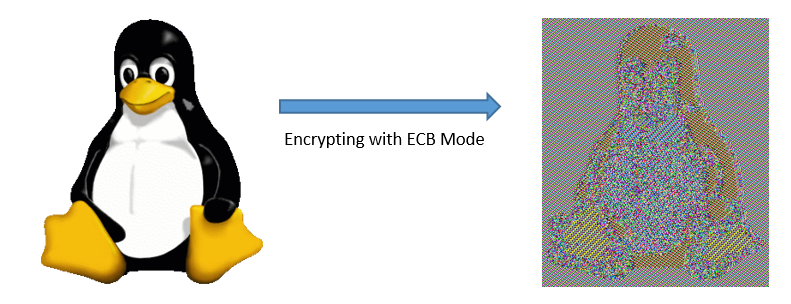
As an example, if we encrypt the image above, we’ll get a scrambled image that still shows some patterns. Although it is encrypted, the image is still recognizable.
Advantages:
- Simple and fast; allows random access to blocks.
Disadvantages:
- Patterns in plaintext are retained in ciphertext
- Identical plaintext blocks result in identical ciphertext blocks
- This makes it vulnerable to analysis
Cipher Block Chaining (CBC)
Each block of plaintext is XORed with the previous ciphertext block before encryption. The first block uses an initialization vector (IV).
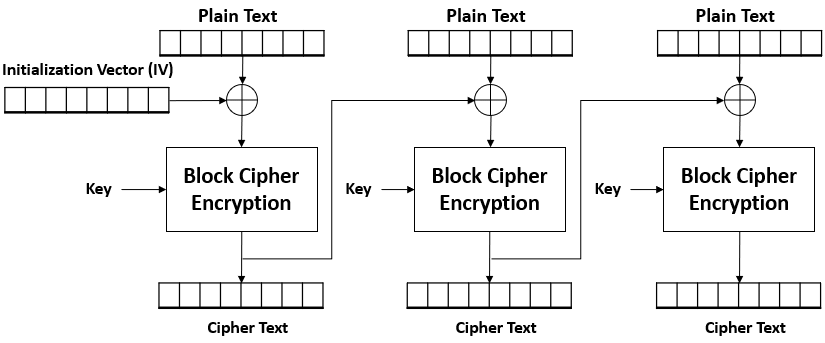
Initialization vector
- Same size as the other blocks.
- The first block is applied with XOR using the IV.
- The output will then be used as the IV for the next block, repeating the cycle.
Advantages:
- Adds randomness to encryption
- Even identical plaintext blocks yield different ciphertext due to chaining.
Disadvantages:
- Requires sequential processing
- Small changes in plaintext can affect the whole chain
- Complicates decryption if data is corrupted
Cipher Feedback (CFB)
Turns block ciphers into self-synchronizing stream ciphers. The previous ciphertext block (or IV) is encrypted and then XORed with the plaintext to produce ciphertext.
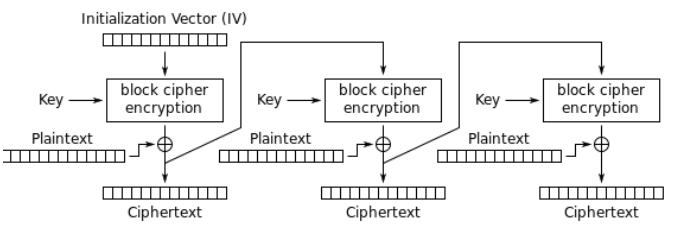
Advantages:
- Provides flexibility in block size
- Allows for partial block updates
- Ideal for real-time encryption
Disadvantages:
- More complex error propagation
- If an error occurs, it affects multiple blocks
Output Feedback (OFB)
Similar to CFB, but the encrypted output (keystream) is generated independently of the plaintext and then XORed with the plaintext to produce ciphertext.
- IV is encrypted, then output is XORed to first block
- Same IV is used throughout the process.
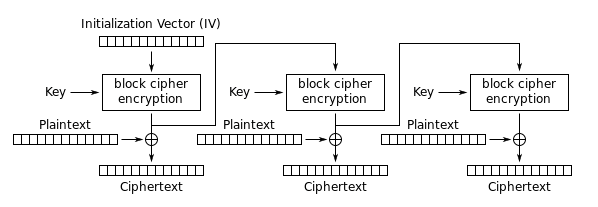
Advantages:
- Errors in ciphertext do not propagate
- Ideal for secure data streaming
Disadvantages:
- If the same IV and key are reused, the entire encryption can be compromised
- Requires careful management of IVs
Counter (CTR)
Converts block ciphers into stream ciphers by using a counter that is encrypted to produce a keystream, which is then XORed with the plaintext.
- Uses a Nonce value + counter value
- Counter increments in binary
- Both are combined and then encrypted
- First block of plaintext ix XORed with the encrypted NONCE+Counter
- Output becomes the ciphertext
- Repeat steps for each block of plain text

Advantages:
- Allows for parallel processing
- Errors do not propagate
- Noo chaining issues
- Widely used in modern applications
Disadvantages:
- Counter and key must never repeat
- Can be vulnerable to attacks if not implemented carefully
Galois/Counter Mode (GCM)
Combines CTR mode with a message authentication code (MAC) to ensure data integrity and confidentiality.
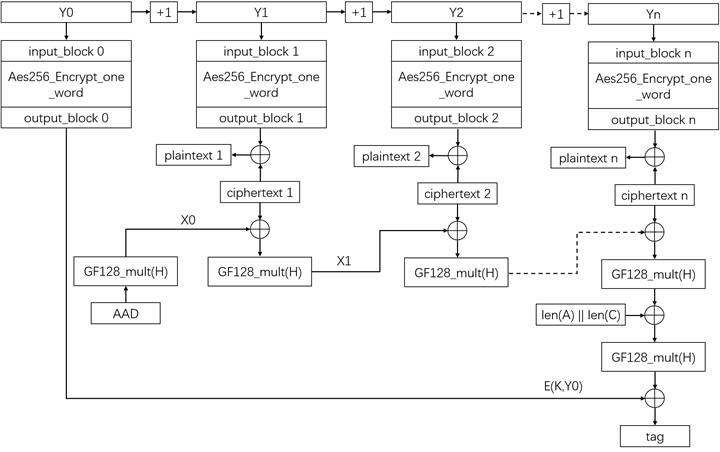
Advantages:
- Provides authenticated encryption
- Ensures that ciphertext has not been tampered with
- Supports parallel processing
Disadvantages:
- More complex implementation
- Requires careful management of IVs and counters